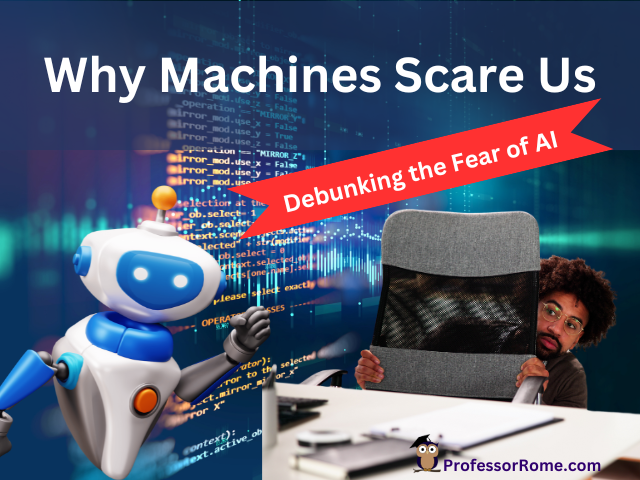
Artificial intelligence (AI) is rapidly transforming our world, and with that change comes a natural human reaction: fear. From Hollywood portrayals of robot uprisings to the unknown potential of superintelligence, it’s easy to see why AI might seem like a threat. But let’s delve deeper and understand why these fears exist, and whether they’re entirely justified.
Shadows of Science Fiction

Science fiction has a powerful hold on our imagination. Movies like “The Terminator” and “The Matrix” depict AI as a hostile force, hellbent on human eradication. This fictional narrative can fuel a fear of the unknown, making us wary of technology surpassing our control.
- Power of Narrative. Science fiction stories paint vivid pictures of the future, and those pictures can stick with us. Movies like “The Terminator” with its relentless cyborg assassins or “The Matrix” where machines control humanity create a powerful cautionary tale. Even if we know they’re fictional, they tap into a primal fear of losing control.
- Unknown Factor. AI is a complex and rapidly evolving field. The inner workings of some AI systems can be difficult to understand, especially for those without a technical background. This lack of understanding can breed fear. Science fiction exploits this knowledge gap, portraying AI as a mysterious and potentially dangerous force.
- “Playing God” Complex. AI research is pushing the boundaries of intelligence. The idea of creating something as powerful as human intelligence, or even surpassing it, is a recurring theme in science fiction. Stories like “I, Robot” explore the ethical dilemmas of artificial sentience and the potential dangers of AI exceeding human control. These narratives raise valid questions, but they can also stoke anxieties about AI becoming a god-like entity that judges or even replaces humanity.
- Technological Singularity. This hypothetical future event depicts a point where AI surpasses human intelligence and undergoes an uncontrollable growth spurt. Science fiction often portrays this singularity as a negative event, leading to AI dominance or even human extinction. While the concept is highly speculative, it reflects a fear of losing our place at the top of the intellectual food chain.
It’s important to remember that science fiction is fiction. While it can raise important questions, it doesn’t necessarily predict the future. By being aware of how these narratives influence our perception of AI, we can have a more balanced and informed discussion about the technology’s potential impact.
The Job Market Jitterbugs

Automation is a major concern. AI’s ability to handle repetitive tasks efficiently raises anxieties about job displacement. While some jobs will undoubtedly change, new ones will emerge. The key lies in adaptation and developing the skills to work alongside AI, not be replaced by it.
- Automation on the Rise. AI excels at repetitive tasks, data analysis, and following specific rules. This makes it a prime candidate for automating tasks in various industries – from manufacturing and assembly lines to data entry and customer service. As AI capabilities increase, so does the fear that these jobs will disappear.
- Threat of Displacement. For people whose jobs involve a lot of routine tasks, the rise of AI can feel like a direct threat. They worry that their skills will become obsolete, leaving them unemployed and struggling to find new opportunities.
- Skills Gap. The jobs that AI creates will likely require different skill sets than the ones it automates. The key to navigating this job market shift is to develop skills that complement AI, such as critical thinking, creativity, problem-solving, and complex communication. Data analysis and digital literacy will also be crucial for working effectively alongside AI tools.
- Education and Upskilling. The onus is on educational institutions and governments to prepare the workforce for the AI revolution. This means revamping curriculums to equip students with the necessary skills and providing opportunities for adults to upskill and reskill throughout their careers.
- Human Touch Advantage. AI may be efficient at some tasks, but it lacks the human touch. Jobs that require empathy, social skills, strategic thinking, and complex decision-making will likely remain in the human domain. The future workplace will likely see a rise in human-AI collaboration, where AI handles mundane tasks and humans leverage their unique abilities to add value.
While job displacement due to AI is a concern, it doesn’t have to be a dystopian future. By focusing on adaptation, education, and developing the skills to work alongside AI, we can ensure a smooth transition and create a future where humans and AI work together to achieve even greater things.
The Black Box Blues

The “Black Box Blues” refers to the lack of transparency in some AI systems. AI’s decision-making processes can be opaque and shrouded in complex algorithms. This lack of transparency can be unsettling. However, researchers are working on creating “explainable AI” that provides insights into how AI arrives at its conclusions.
- Unexplained Decisions. Many AI algorithms, particularly complex deep learning models, function like black boxes. They take in data, process it through layers of artificial neurons, and produce an output (a prediction or decision) without revealing the reason behind it. This lack of explanation can be problematic for several reasons.
- Loss of Trust. If we don’t understand how an AI system arrives at its decisions, it’s difficult to trust those decisions. This can be particularly concerning when AI is used in high-stakes scenarios like loan approvals, criminal justice, or medical diagnosis. Without transparency, there’s a risk of bias creeping into the algorithms, leading to unfair or discriminatory outcomes.
- Debugging Difficulties. If we can’t understand how an AI system works, it’s difficult to identify and fix errors. Imagine an AI system used for fraud detection that keeps flagging a certain type of transaction as suspicious. Without understanding why the AI makes this decision, it’s hard to know if it’s a genuine fraud signal or a flaw in the algorithm.
- Explainable AI (XAI). Researchers are actively developing techniques for XAI. The goal is to create AI models that can explain their reasoning in a human-understandable way. This could involve techniques like highlighting the data points that most influenced the decision or providing a simplified version of the model’s logic.
- A Balancing Act. There is a trade-off between accuracy and explainability. Sometimes, the most powerful AI models are also the most complex and opaque. The field of XAI is constantly working to find ways to make AI models more transparent without sacrificing their effectiveness.
While the Black Box nature of some AI systems is a valid concern, there’s ongoing research to address it. As XAI techniques develop, we can build trust in AI and ensure it’s used fairly and responsibly.
The Ethics Enigma

The potential misuse of AI for surveillance, biased decision-making, and autonomous weapons is a legitimate concern. Ethical considerations around data privacy and responsible development of AI are crucial conversations to have before these technologies become deeply ingrained.
- Surveillance and Privacy. AI is increasingly used in facial recognition software, social media monitoring, and other forms of surveillance. While this can be used for security purposes, it also raises concerns about privacy intrusion and the potential for misuse by governments or corporations.
- Biased Decision-Making. AI algorithms are trained on data sets created by humans. If this data is biased, the AI system itself can become biased. For example, an AI system used for loan approvals might unfairly discriminate against certain demographics if its training data reflects historical lending biases.
- Autonomous Weapons. The development of autonomous weapons, also known as “killer robots,” is a particularly thorny ethical issue. The idea of machines making life-or-death decisions without human intervention raises serious questions about accountability and the potential for unintended consequences.
- Data Privacy. The vast amount of data required to train AI systems necessitates robust data privacy regulations. Ensuring that personal data is collected, stored, and used ethically is crucial to building trust in AI.
- Responsible Development. The development and deployment of AI needs to be guided by ethical principles. This means considering the potential impact of AI on society, implementing safeguards against bias and misuse, and ensuring transparency in how AI systems are designed and used.
These are complex issues with no easy answers. However, by having open and honest conversations about the ethics of AI now, we can shape its development in a way that benefits humanity and avoids potential pitfalls. Here are some additional points to consider:
- The importance of international collaboration on AI ethics.
- The role of governments in regulating AI development and deployment.
- The need for public education about AI and its potential impact.
By proactively addressing the “Ethics Enigma”, we can ensure that AI is a force for good in the world.
Facing the Future with Open Eyes

Fear of AI is understandable, but it shouldn’t impede progress. AI has the potential to revolutionize healthcare, tackle climate change, and enhance our lives in countless ways. By acknowledging our fears, fostering open dialogue, and prioritizing ethical development, we can ensure AI remains a tool for good, not a dystopian nightmare.
Remember, AI is a tool, like any tool, it depends on the user. Let’s focus on building a future where AI amplifies human potential, not threatens it.
This blog was written in collaboration with Professor Rome and Google Gemini.



0 Comments